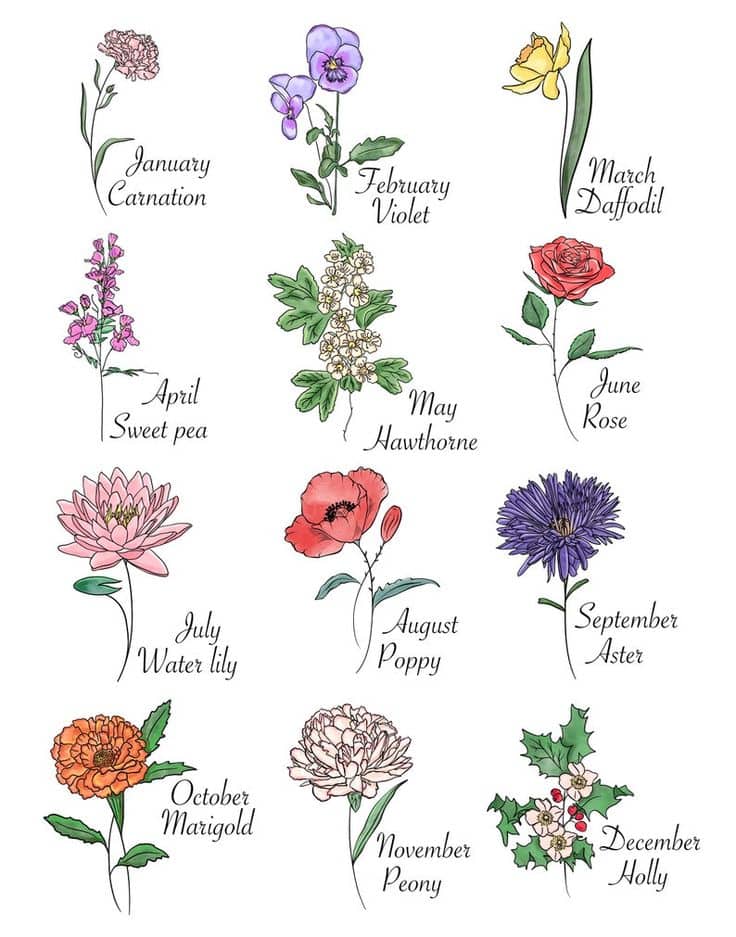Discover the Meaning Behind Each Birth Flower: A Parent’s Guide to Birth Flower Chart
Welcome, wonderful parents, to the fascinating world of birth flowers! Whether you’re a seasoned green thumb or a curious newcomer, this delightful guide is here to sprinkle your day with floral knowledge. Curating the perfect gift for your little one or decorating their room with meaningful blossoms has never been easier. Plus, understanding the unique flowers associated with their birth month is a fantastic way to celebrate their milestones and personality. Let’s cultivate some joy and insight together with this charming Birth Flower Chart!
What Are Birth Flowers?
Just like gemstones, every month of the year is represented by a beautiful flower, each with its own special meaning. Birth flowers are a picturesque tradition that dates back to ancient civilizations, where flowers were believed to hold deep significance and powers. Fast forward to today, and these botanical beauties still make thoughtful gifts that tell a story of identity, virtues, and personal significance.
Your Guide to the Birth Flower Chart
As you journey through the year, you’ll discover that each month comes with not just one, but often multiple flowers that symbolize various traits and lore. Let’s plant the seed of knowledge with a detailed look at what each month’s bloom stands for, starting with the fresh buds of January to the frost-touched petals of December.
January – Carnation & Snowdrop
The year begins with the hearty carnation and the resilient snowdrop as January’s birth flowers. Carnations, with their ruffled petals, come in a rainbow of colors, each shade unfolding its own meaning—from love and fascination to distinction and charm. Snowdrops, peeking through the snow, signify hope and beauty, reminding us of nature’s wonders even in the coldest times.
February – Violet & Primrose
As we tiptoe into February, violets and primroses take center stage. Violets represent loyalty, faithfulness, and young love, a beautiful nod to the nurturing bonds you share with your children. Primroses, with their gentle appearance, hint at the blossoming of new life and the purity of a child’s curiosity. These flowers are perfect for celebrating the joys of youthful innocence.
March – Daffodil & Jonquil
March showers us with the sunny daffodil and its close cousin, the jonquil. These bright, trumpet-shaped flowers are harbingers of spring; their presence echoes themes of rebirth, new beginnings, and unmatched happiness. A daffodil bouquet is the ideal way to welcome a springtime baby into the world, promising a life filled with joy and prosperity.
From the tender buds of spring to the deep hues of autumn, birth flowers embody a tapestry of stories and moments unique to every individual. Embracing the tradition of birth month flowers helps us connect with nature, our loved ones, and the rich symbolism steeped within each petal.
Stay tuned as we continue our stroll through the garden with further insights into the birth flowers of April through June. Blossom by blossom, month by month, we’ll explore the vivid world of these enchanting botanical wonders. Remember, every flower has a story, and with our guide, you can cherish your child’s special floral story that mirrors their growth and the beauty they bring to the world!
So, whether you plan to craft a personalized birthday bouquet, design a themed nursery, or simply educate your little one about their very own birth flower, this guide will be your companion through every sunbeam and raindrop. Let’s nurture the bond with our children by sharing with them the meaningful tales of each and every bloom!
As parents, including the timeless elegance and symbolism of flowers into our family traditions not only brightens our homes but also sows the seeds of cultural appreciation in our children’s hearts. Stay with us as we continue to uncover the joys of each month’s botanical beauties in the rest of our guide, illuminating the path from July’s water lily to December’s holly with the same loving detail.

Five Things Parents Should Know in Preparing for a Birth Flower Chart
- Know the Birth Month and Corresponding Flowers: Familiarize yourself with your child’s birth month and its representative flowers. Each month may have more than one associated bloom, so understanding the differences and meanings is a delightful way to start this floral journey!
- Learn the Language of Flowers: Delve into the fascinating language of flowers—known as floriography. Each flower not only symbolizes a particular quality or emotion but can also tell a unique story when combined with others. This will help you create even more personalized and meaningful arrangements or gifts.
- Consider Flower Availability: While you may be excited to celebrate your child’s birth month with the right flower, consider the season and the bloom’s availability. You might need to plan ahead to source certain flowers or opt for high-quality silk replicas if the real ones are out of season.
- Think About Allergies: If you’re planning to bring fresh flowers into your home, be aware of any allergies your family might have. It’s important to choose flowers that won’t trigger allergic reactions, ensuring a safe and comfortable environment for everyone.
- Get Creative with Birth Flower Themes: Don’t limit the birth flower theme to bouquets—extend it to nursery decor, custom artwork, and even educational storytelling. Use the symbolism of the birth flower to inspire creative projects and learning opportunities that will grow alongside your child.
April – Daisy & Sweet Pea
April showers bring forth the cheerful daisy and the fragrant sweet pea. Daisies are synonymous with innocence, purity, and true love. They’re like little rays of sunshine in petal form, dotting the world with positivity and cheer. Sweet peas, with their ruffled blooms and alluring scent, symbolize blissful pleasure and serve as a reminder of the sweet innocence and delicate nature of a newborn.
May – Lily of the Valley & Hawthorn
May’s blossoms include the delicate Lily of the Valley and the robust Hawthorn. Lily of the Valley, with its dainty bells, signifies humility, chastity, and the return of happiness—a beautiful tribute to the purity and joy that children bring. Hawthorn flowers, signaling hope and supreme happiness, provide an enchanting tale of resilience and protection to share with your young ones.
June – Rose & Honeysuckle
In June, we celebrate with the classic rose and the sweet-scented honeysuckle. The rose, in its myriad colors, speaks a complex language of love, honor, faith, and beauty. The nature of the relationship you share with your child can be reflected in the color of the rose you choose. Honeysuckle, with its strong, sweet fragrance, stands for the bonds of love and the sweetness of life, capturing the essence of the deep connection between parent and child.
As we dip our toes in the mid-year blooms, let’s not forget to keep exploring. The second half of the year brings even more spectacular flowers and meanings to discover, from the fiery gladiolus of August to the festive poinsettia of December. Whether it’s through a birthday celebration, a crafting session, or a bedtime story, the world of birth flowers offers endless opportunities to nurture your child’s imagination and express your love.
Remember to bookmark this guide as your go-to companion for all things birth flower related. With each passing year, your child will not only grow taller but also grow deeper in their connection with their birth month blooms. Celebrate each milestone with a fresh bouquet or a new story, ensuring that the legacy of their special flowers is lovingly woven into the fabric of their childhood memories.
It’s a delightful journey ahead, so keep nurturing, keep learning, and most of all, keep enjoying the natural beauty and symbolism offered by our enchanting birth flower chart. After all, the right flower can speak directly to the heart, and what more beautiful conversation could there be between a parent and their child?
See more great Things to Do with Kids in New Zealand here. For more information see here
Disclaimer
The articles available via our website provide general information only and we strongly urge readers to exercise caution and conduct their own thorough research and fact-checking. The information presented should not be taken as absolute truth, and, to the maximum extent permitted by law, we will not be held liable for any inaccuracies or errors in the content. It is essential for individuals to independently verify and validate the information before making any decisions or taking any actions based on the articles.




